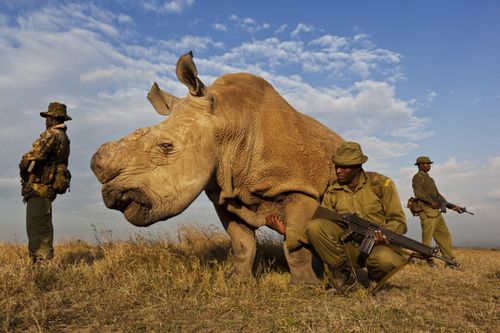RHINO WARS A white rhino cow is dehorned as a precautionary anti-poaching measure on a game farm in South Africa. A vet's assistant holds the horns for an identity picture while the vet does a final check on the animal. By Brent Stirton

A four man anti-poaching team permanently guards a Northern White Rhino on Ol Pejeta Conservancy in Kenya. The conservancy is an important not-for-profit wildlife conservancy in the Laikipia District of Kenya and the largest sanctuary for black rhinos in East Africa. It is also the home of four of the remaining eight Northern White Rhino, the world’s most endangered animal. Rhino horn is now worth more than gold on the international market. South Africa alone has lost more than 400 rhino to illegal poaching incidents in 2011. The demand for Rhino horn is fueled by a wealthy Asian middle and upper class and used overwhelmingly as medication.

Game scouts found this black rhino bull wandering Zimbabwe's Savé Valley Conservancy after poachers shot it several times and hacked off both its horns. Veterinarians had to euthanize the animal because its shattered shoulder couldn't support its weight. In the past six years poachers have killed more than a thousand African rhinos for their horns, which are smuggled to Asia for use in traditional medicines.

( Brent Stirton, Getty Images / November 9, 2010 )
Brent Stirton, a Getty Images photographer working for National Geographic magazine, has won first prize Nature Stories for the "Rhino Wars" series. The picture shows a female rhino in Tugela Private Game Reserve, Colenso, Natal, South Africa, that four months earlier survived a brutal dehorning by poachers who used a chainsaw to remove her horns and a large section of bone in that area of her skull. The female rhino survived the dehorning and has joined up with a male bull who now accompanies her. Rhino horn is now worth more than gold on the international market. South Africa alone has lost more than 400 rhinos to illegal poaching incidents in 2011. The demand for Rhino horn is fueled by a wealthy Asian middle and upper class and used overwhelmingly as medication.

An eight-pound rhino horn like this one can reap up to $360,000 on the black market. (Photo: ©Brent Stirton/National Geographic)

Aucun commentaire:
Enregistrer un commentaire